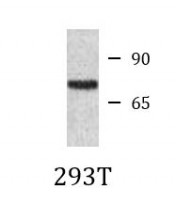ARG40962
anti-FOXK2 / ILF antibody
anti-FOXK2 / ILF antibody for Western blot and Human
概述
| 产品描述 | Rabbit Polyclonal antibody recognizes FOXK2 / ILF |
|---|---|
| 反应物种 | Hu |
| 预测物种 | Hu, Ms, Rat, Cow, Dog, Hrs, Pig, Rb, Zfsh |
| 应用 | WB |
| 宿主 | Rabbit |
| 克隆 | Polyclonal |
| 同位型 | IgG |
| 靶点名称 | FOXK2 / ILF |
| 抗原物种 | Human |
| 抗原 | Synthetic peptide around the middle region of Human FOXK2. (within the following region: GTASRIIQTAQTTPVQTVTIVQQAPLGQHQLPIKTVTQNGTHVASVPTAV) |
| 偶联标记 | Un-conjugated |
| 別名 | ILF; ILF1; ILF-1; nGTBP; Forkhead box protein K2; Cellular transcription factor ILF-1 |
应用说明
| 预测反应性说明 | Predicted Homology Based On Immunogen Sequence: Cow: 100%; Dog: 100%; Horse: 100%; Mouse: 100%; Pig: 100%; Rabbit: 100%; Rat: 100%; Zebrafish: 100% | ||||
|---|---|---|---|---|---|
| 应用建议 |
|
||||
| 应用说明 | * The dilutions indicate recommended starting dilutions and the optimal dilutions or concentrations should be determined by the scientist. |
属性
| 形式 | Liquid |
|---|---|
| 纯化 | Affinity purified. |
| 缓冲液 | PBS, 0.09% (w/v) Sodium azide and 2% Sucrose. |
| 抗菌剂 | 0.09% (w/v) Sodium azide |
| 稳定剂 | 2% Sucrose |
| 浓度 | Batch dependent: 0.5 - 1 mg/ml |
| 存放说明 | For continuous use, store undiluted antibody at 2-8°C for up to a week. For long-term storage, aliquot and store at -20°C or below. Storage in frost free freezers is not recommended. Avoid repeated freeze/thaw cycles. Suggest spin the vial prior to opening. The antibody solution should be gently mixed before use. |
| 注意事项 | For laboratory research only, not for drug, diagnostic or other use. |
生物信息
| 数据库连接 | |
|---|---|
| 基因名称 | FOXK2 |
| 全名 | forkhead box K2 |
| 背景介绍 | The protein encoded by this gene contains a fork head DNA binding domain. This protein can bind to the purine-rich motifs of the HIV long terminal repeat (LTR), and to the similar purine-rich motif in the interleukin 2 (IL2) promoter. It may be involved in the regulation of viral and cellular promoter elements. [provided by RefSeq, Jul 2008] |
| 生物功能 | Transcriptional regulator involved in different processes such as glucose metabolism, aerobic glycolysis and autophagy (By similarity). Recognizes and binds the forkhead DNA sequence motif (5'-GTAAACA-3') and can both act as a transcription activator or repressor, depending on the context (PubMed:22083952, PubMed:25451922). Together with FOXK1, acts as a key regulator of metabolic reprogramming towards aerobic glycolysis, a process in which glucose is converted to lactate in the presence of oxygen (By similarity). Acts by promoting expression of enzymes for glycolysis (such as hexokinase-2 (HK2), phosphofructokinase, pyruvate kinase (PKLR) and lactate dehydrogenase), while suppressing further oxidation of pyruvate in the mitochondria by up-regulating pyruvate dehydrogenase kinases PDK1 and PDK4 (By similarity). Probably plays a role in gluconeogenesis during overnight fasting, when lactate from white adipose tissue and muscle is the main substrate (By similarity). Together with FOXK1, acts as a negative regulator of autophagy in skeletal muscle: in response to starvation, enters the nucleus, binds the promoters of autophagy genes and represses their expression, preventing proteolysis of skeletal muscle proteins (By similarity). In addition to the 5'-GTAAACA-3' DNA motif, also binds the 5'-TGANTCA-3' palindromic DNA motif, and co-associates with JUN/AP-1 to activate transcription (PubMed:22083952). Also able to bind to a minimal DNA heteroduplex containing a G/T-mismatch with 5'-TRT[G/T]NB-3' sequence (PubMed:20097901). Binds to NFAT-like motifs (purine-rich) in the IL2 promoter (PubMed:1339390). Positively regulates WNT/beta-catenin signaling by translocating DVL proteins into the nucleus (PubMed:25805136). Also binds to HIV-1 long terminal repeat. May be involved in both positive and negative regulation of important viral and cellular promoter elements (PubMed:1909027). [UniProt] |
| 细胞定位 | Nucleus. [UniProt] |
| 预测分子量 | 69 kDa |
检测图片 (1) Click the Picture to Zoom In






